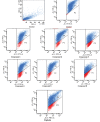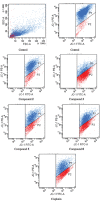Comprehensive Study on Thiadiazole-Based Anticancer Agents Inducing Cell Cycle Arrest and Apoptosis/Necrosis Through Suppression of Akt Activity in Lung Adenocarcinoma and Glioma Cells
- PMID: 32454705
- PMCID: PMC7227970
- DOI: 10.4274/tjps.galenos.2019.2018.96658
Comprehensive Study on Thiadiazole-Based Anticancer Agents Inducing Cell Cycle Arrest and Apoptosis/Necrosis Through Suppression of Akt Activity in Lung Adenocarcinoma and Glioma Cells
Abstract
Objectives: Akt is considered as an attractive target for anticancer drug discovery and development and therefore extensive efforts have been devoted to the discovery of new potent anticancer agents targeting Akt.
Materials and methods: Due to the importance of thiadiazoles for anticancer drug discovery, herein eight 1,3,4-thiadiazole derivatives were investigated for their cytotoxic effects on C6 rat glioma and A549 human lung adenocarcinoma cell lines using the MTT assay. The effects of the most promising anticancer agents on apoptosis, caspase-3 activation, mitochondrial membrane potential, and cell cycle arrest were determined on a BD FACSAria (I) flow cytometer. Akt activity was measured in the C6 and A549 cell lines using an ELISA colorimetric method. Schrödinger's Maestro molecular modeling package was used to explore the possible binding modes of compounds 3 and 8 in the active site of Akt enzyme (PDB code: 3OW4).
Results: N-(4-Chlorophenyl)-2-[(5-((4-nitrophenyl)amino)-1,3,4-thiadiazol-2-yl)thio]acetamide (3) and N-(6-nitrobenzothiazol-2-yl)-2-[(5-((4- nitrophenyl)amino)-1,3,4-thiadiazol-2-yl)thio]acetamide (8) induced apoptosis and cell cycle arrest in the C6 cell line through inhibition of Akt activity (92.36% and 86.52%, respectively). The docking results of compounds 3 and 8 indicated that π-π interactions, H bonds, and salt-bridge formation were responsible for the observed Akt inhibitory activity.
Conclusion: According to in vitro and docking studies, compounds 3 and 8 stand out as promising antiglioma agents.
Keywords: Akt activity; Apoptosis; Cancer; Molecular docking; Thiadiazole.
©Copyright 2019 Turk J Pharm Sci, Published by Galenos Publishing House.
Conflict of interest statement
Conflict of Interest: No conflict of interest was declared by the authors.
Figures








References
-
- McDowell KA, Riggins GJ, Gallia GL. Targeting the AKT Pathway in Glioblastoma. Curr Pharm Des. 2011;17:2411–2420. - PubMed
-
- Cassinelli G, Zuco V, Gatti L, Lanzi C, Zaffaroni N, Colombo D, Perego P. Targeting the Akt Kinase to Modulate Survival, Invasiveness and Drug Resistance of Cancer Cells. Curr Med Chem. 2013;20:1923–1945. - PubMed
LinkOut - more resources
Full Text Sources
Research Materials
Miscellaneous
